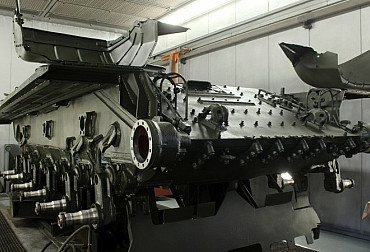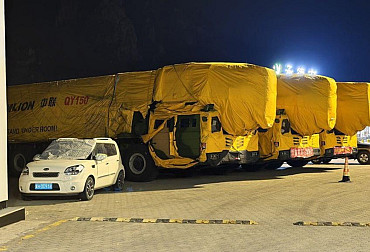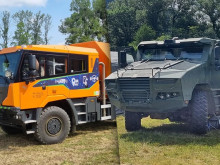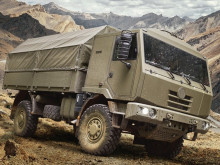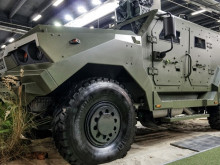Lessons from Ukraine: effective cooperation between troops is the key to success
Russia's aggression against Ukraine, which has been going on for almost five months now, has become an extremely valuable source of lessons for the armies of Western countries from the very first days. It was generally expected that Ukraine would not be able to resist the Russian invasion with conventional forces for more than a few weeks and that Russia would prevail, although it would probably then have to face guerrilla warfare. However, the situation soon took a very different turn, as the Ukrainians showed exceptional determination, morale and tactical mastery, while the Russian Army was clearly plagued by enormous problems of technique, tactics, logistics, command and morale. Thus, a wide range of conclusions can be drawn from the performances or successes and failures of the armies of both sides for the current processes of modernisation of the armies of NATO and EU countries. Of course, this also applies to the Czech Army, or to some of its ongoing or planned military equipment acquisition programmes.
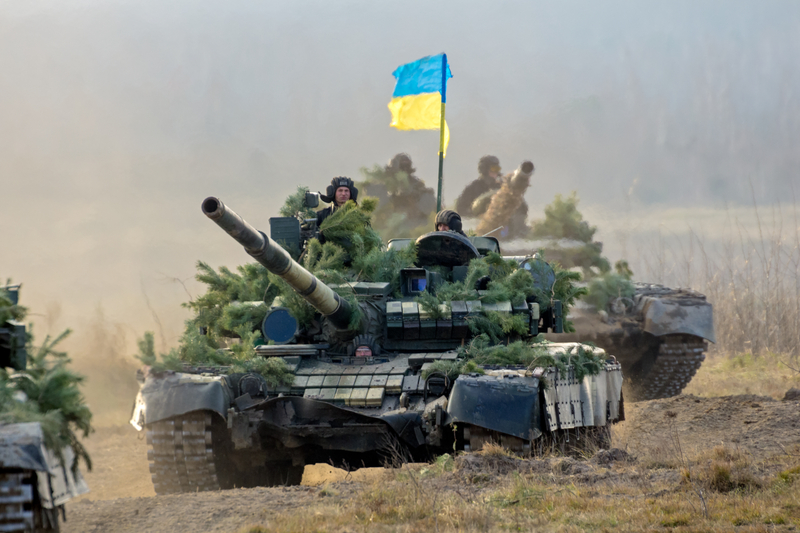 Picture: The Ukrainians have shown exceptional resolve, morale and tactical mastery, while the Russian Army is clearly plagued by huge problems with equipment, tactics, logistics, command and morale. (illustration photo) | Shutterstock
Picture: The Ukrainians have shown exceptional resolve, morale and tactical mastery, while the Russian Army is clearly plagued by huge problems with equipment, tactics, logistics, command and morale. (illustration photo) | Shutterstock
A brief overview can start with tanks, as this category of equipment has long been the subject of great and sometimes irrational controversy. The huge losses of Russian tanks in Ukraine, which are already practically equivalent to a quarter of their pre-war level (as Russia has already lost around 700 of the approximately 2,800 tanks in active service), have led to the proclamation that tanks are simply obsolete and becoming irrelevant as they are easy victims of modern anti-tank missiles. This is by no means the first time that this view has emerged, but the reality has so far always proved to be different and far more complex. Indeed, analyses of the battles in the Ukraine demonstrate that these heavy losses of Russian tanks do not result from the obsolescence of the tanks as such, but far more from inappropriate tactics. To some extent, then, the situation in Chechnya is repeated, where Russian tanks also suffered defeat in the battles for Grozny, which then led to a general condemnation of this category of vehicles, even though it has become clear that Russian commanders made huge mistakes in deploying tanks in the first place. The same can therefore now be said of the fighting in Ukraine.
Tanks continue to be a hugely effective combination of firepower, armour protection and off-road mobility, but this is only true if they function as an organic part of a military force that also contains other essential components. After all, it was already proven in World War II that tanks can be relatively easily vulnerable, especially to anti-tank guns and portable (infantry) anti-tank weapons. Tanks must therefore be accompanied by infantry, which must keep pace with them and should also have an adequate degree of protection. This gave rise to motorised and then mechanised infantry, which usually works with tanks because they can effectively deal with threats that tanks alone can only deal with to a limited extent. This has subsequently been confirmed in other conflicts, e.g. in Korea or the Middle East. It is clear, however, that although Russian commanders certainly know these principles in theory, they are unable to implement them properly in practice, which is why Ukrainian anti-tank weapons are destroying Russian tanks.
However, if anything has really proven to be clearly outdated, it is the Soviet, and hence Russian, tank design school. The latter traditionally prefers lower weight and a small silhouette in tanks, but at the expense of crew protection. In fact, Russian tanks have reloading machines located in the turret, where most of the ammunition is also located. Thus, armour penetration is usually followed by a secondary explosion, which then rips the turret from the hull and causes the immediate death of the crew. The result is the total loss of the vehicle and three soldiers. Western tanks are designed completely differently, as the ammunition is stored separately from the crew, who therefore have a good chance of survival even in the event of an explosion. In addition, modern Western tanks generally have much stronger armour protection. The same is true, after all, of infantry fighting vehicles, as a large number of BMP series tracked vehicles have also been destroyed in Ukraine. Although these are light and fast, the level of protection for the crew and the infantry being transported is trivial. In the event of a breach in the armour, those in the armoured vehicle have little chance of escaping unharmed.
The lesson for the Army of the Czech Republic is that the heavy mechanized brigade now being built must have modern Western armoured vehicles, tanks and infantry fighting vehicles. For reservists, perhaps the modernised T-72 tanks can still be considered sufficient, but active units absolutely need brand new vehicles. In the case of tanks, the most suitable solution seems to be the German Leopard 2 type, which is already in use in the armies of four neighbouring countries, i.e. Germany, Austria, Poland and Hungary, and will probably also appear in the Slovak Army. The Leopard 2 tank is undoubtedly the world's top tank in its category, its design is proven in service and at the same time still offers evolutionary potential. In addition to the acquisition of new tanks, it is essential to finally bring to a successful conclusion the selection of new infantry fighting vehicles that will offer a dramatically higher level of armour protection and destructive power compared to the BVP-2 type in service today. Tanks and infantry armour must work closely together to form a perfectly integrated unit that can effectively counter all threats on the battlefield.
In addition to tracked infantry armoured vehicles, wheeled armoured vehicles are also highly effective in contemporary conflicts. It is generally accepted that although they cannot compete with tracked types in terms of durability, many modern wheeled armoured vehicles are quite equal to tracked ones in terms of firepower. Of course, wheeled vehicles clearly dominate in terms of road speed, which can play a significant role if there is a conflict in a region with a dense network of fixed roads, as wheeled armoured vehicles can get to the required location much faster than tracked ones. The Czech Army should therefore continue to invest in the acquisition and evolution of vehicles based on the proven eight-wheeled Pandur II platform. In the first place, it is necessary to replace the now inadequate RCWS-30 turrets with a different, more modern and durable type of unmanned turret. Furthermore, it would be advisable to procure newly manufactured examples of Pandur II vehicles both in combat configuration and in support variants, but in any case already in the new standard, which offers, inter alia, significantly higher protection against ballistic and explosive threats.
However, quality logistic support must also be an essential part of mechanised troops. The course of the fighting in Ukraine shows that a significant part of Russia's military failures stems from inefficient and weak logistics, as the Russian Army is clearly unable to provide its forces with the necessary support on the battlefield, which includes the supply of ammunition, fuel and food or the recovery of damaged or stranded equipment. The Russian Army suffers from a shortage of trucks, which, moreover, have serious operational problems. The preference for conventional trucks significantly reduces the speed of loading and unloading, while the absence of armoured cabs on the vast majority of trucks means that they are easily vulnerable. The Ukrainian Army is obviously very aware of all these weaknesses of the enemy and therefore focuses much of its efforts on Russian logistics. Attacks on poorly protected Russian supply convoys then quite legitimately mean that Russian troops on the front line cannot conduct offensive operations as planned.
The Czech Army enjoys an advantage that even many armies of developed countries do not have, as an experienced and prestigious manufacturer of heavy trucks, which form the backbone of Czech military logistics, operates on Czech territory. Therefore, Tatra vehicles should also be an important element of support for the heavy mechanised brigade. To this end, new Tatra Force series vehicles should be purchased, optimally equipped with container carriers or pallet systems, as these devices dramatically increase the efficiency of loading and unloading. The Army also needs tankers for fuel and drinking water. For the movement of tanks and infantry fighting vehicles, 'tank transporters', i.e. powerful tractors and sleepers, are essential, as tracked vehicles are usually transported over longer distances in this way so that their running gear does not suffer and the road surface is not damaged. In addition, as many trucks as possible should be purchased with armoured driver's cabs, as this dramatically increases their chances of surviving hostile action.
Another important item is the engineer troops that help overcome obstacles on the battlefield. In Ukraine, this was demonstrated, for example, in early May during the Russian attempt to cross the North Donetsk River, in which the Russian Army lost dozens of armoured vehicles. Detailed analyses of this event are still ongoing, but it seems that poor coordination was (again) to blame, as large Russian forces gathered near the banks and then waited a long time for the arrival of engineers and the construction of pontoon bridges, which the Ukrainian side naturally took advantage of. In any case, the Czech Army should invest in a comprehensive renewal of its fleet of bridge systems, which includes, among other things, mechanised bridges on vehicles and pontoon bridge sets. A suitable solution could be, for example, the AM-70EX bridge car, whose bridge can also handle heavy Western tanks, and the IRB pontoon set from General Dynamics European Land Systems, which (like the AM-70EX) uses Tatra Force chassis.
The war in Ukraine also reaffirms the huge importance of artillery, and shows that an army with greater brute destructive power is certainly not necessarily of greater combat value. The Russian side possesses a greater number of guns and rocket launchers than the Ukrainian side, but Ukraine has much more advanced means of directing and guiding artillery fire. Ukrainian weapons therefore fire much more flexibly, quickly and accurately than Russian weapons, so their real combat value is much higher than that of Russian ones. This difference is all the more remarkable if we take into account the fact that most of the artillery arsenal of both sides is represented by identical or very similar weapons that date back to Soviet times. However, the situation is now being greatly transformed by the new Western 155 mm howitzers that Ukraine is acquiring and deploying. Compared to the Russian ones, they offer, among other things, a longer range and higher ammunition efficiency, which further increases the Ukrainian side's capabilities. Incidentally, the destruction of Russian forces on the banks of the North Donets was probably due mainly to the precision fire of the M777 towed howitzers that Ukraine acquired from several NATO countries.
The lessons learned from this conflict therefore prove the correctness of the Czech Army's decision to purchase new self-propelled 155 mm calibre howitzers, namely the French Caesar weapons on Tatra chassis. This is a powerful and combat-proven type, which allows firing at a distance of almost 40 km and the use of "smart" ammunition, including Excalibur projectiles with satellite guidance, which, after all, have already been delivered to Ukraine. The Caesar howitzers were also deployed by the Ukrainian Army in the second half of May. Also of paramount importance is the ability of the Caesar weapon to work with modern command and control systems, allowing gunners to receive target location data and quickly adjust firing elements. The highly mobile Caesar thus represents an ideal tool for "shoot & scoot" tactics, where the gun takes up position, fires a few shots and then quickly leaves the position to avoid retaliatory fire from the enemy. It is also worth noting that artillery rocket launchers are proving very effective in Ukraine and therefore the Czech Army should consider reintroducing this highly effective category of weapons.
Another component that deserves attention is air defence. Air superiority remains an extremely important factor, and the fact that Russia has still not managed to gain air superiority over Ukraine is a significant factor in the failures of the Russian offensive. It has failed to suppress Ukrainian air defences, which therefore continue to inflict significant losses on the Russian air force. Portable systems such as the Stinger are credited with the greatest number of aircraft and Red Star helicopters destroyed, but medium- and longer-range systems are also gaining success, and are apparently capable of destroying some of Russia's cruise missiles. A huge problem for the Russian side is then posed by Ukrainian unmanned aerial vehicles, not only the famous Turkish Bayraktar TB2 fighters, but also smaller reconnaissance and attack drones. The Russian military clearly lacks systems that can effectively deal with this threat, as even vaunted types like Pancir or Tor are unable to provide adequate protection, so Ukrainian drones dramatically increase Ukrainian awareness of the tactical situation on the battlefield.
From this we can deduce the correctness of the Czech Army's decision to get rid of the old Soviet Kub complexes and buy top-quality Spyder systems from the Israeli company Rafael, which can effectively engage aircraft, helicopters and cruise missiles. This system includes the excellent EL/M-2084 multi-purpose radar, which was originally developed for the Iron Dome complex but has since found many other applications. It can intercept and track all kinds of airborne targets, including artillery projectiles and small drones. At this point, therefore, it should be emphasised that the Czech Army should invest not only in the acquisition of the drones themselves, but also in means of defence against them. It is therefore worth noting that Czech industry already offers, among other things, the high-end ReGuard radar, which can track even small drones, and directional jammers that can disable the control and navigation of drones. In any case, it is necessary to connect these various defence elements into one integrated system, which can then ensure quality air defence of the entire Czech territory and the Czech Army units.
After all, the air defence of combat units should also be given attention, because despite the undoubted qualities of the Spyder complex, it is, after all, a weapon that should primarily provide defence of territory and static objects, or critical infrastructure. The components of the Spyder system are mounted on a Tatra Force chassis, which of course provides them with high mobility, but due to the design of the entire system it is not possible for it to protect, for example, advancing tank or mechanised forces. The air defence of these units will therefore have to be handled differently. Modern infantry armoured vehicles generally have the ability to fire their guns at air targets, but this capability should be complemented by other means. For example, the chassis of a Pandur II wheeled armoured vehicle or a new infantry fighting vehicle could be used to mount a jamming system to protect against drones, and another option could be a mobile close defence missile suite using the already established RBS-70/NG anti-aircraft missiles on a suitable wheeled or tracked chassis.
However, the proverbial red thread running through all of the previous theses is the maximal appeal to the effectiveness of coordination and cooperation between different types of troops. Tanks undoubtedly still have enormous potential, but they can only be used with the support of mechanised infantry. Tanks and infantry armour need quality logistical support, which will be provided by trucks. The same, of course, applies to artillery, which remains the primary tool for destroying enemy forces beyond visual contact. And all of these components need an effective "umbrella" in the form of air defenses. Therefore, the acquisition plans of the Czech Army should also reflect the awareness that each component of the current armed forces has a specific mission and that all components must support and complement each other to achieve synergy. In short, the modern Army must be characterised by the whole being more than the sum of its parts.













